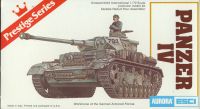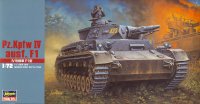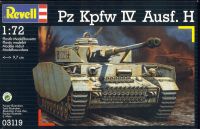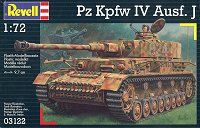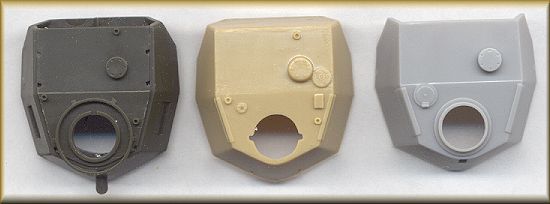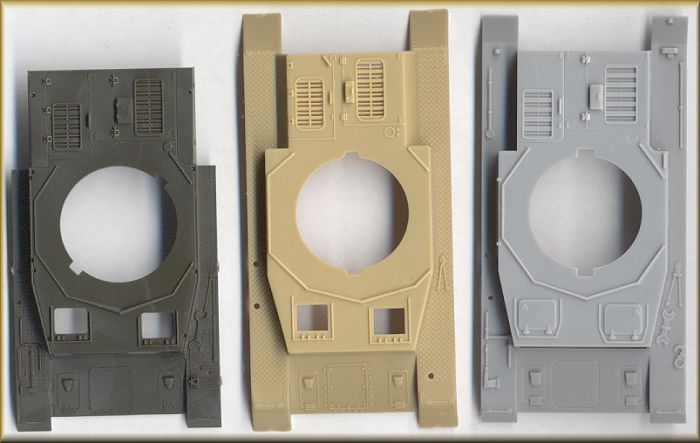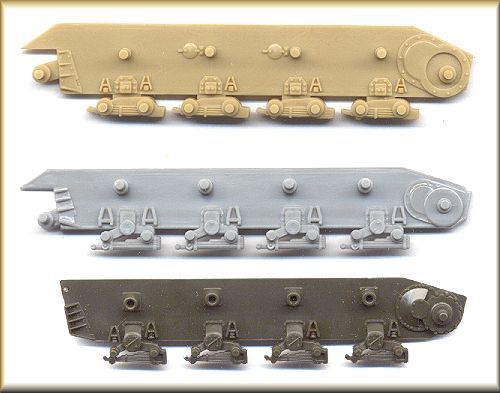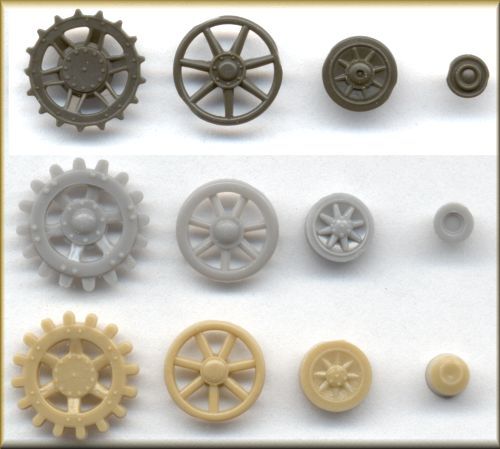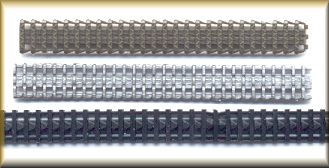| It doesn't happen
often, but as the years go by, it's becoming more and
more frequent: the situation of having more than one
manufacturer making a model kit of the same military
vehicle. For the longest time, the only 1/72nd scale kit
of the ubiquitous Panzerkampfwagen IV was the mediocre
effort by the now-defunct Italian firm of ESCI. In 1999 Hasegawa released three versions of the Panzer IV,
and now thanks to Revell AG., we have another two contenders. The purpose of this article is to evaluate the different plastic model kits of the Panzer IV which are available in 1/72nd scale, by comparing their strengths and weaknesses. But it should be noted, however, that in some ways, this will be comparing apples to oranges, in that many of the kits are of different versions of the tank. So although we are therefore still limited to what we can build straight from the box, hopefully with some creative kitbashing, we will be able to build an accurate model of every common variant of this very important fighting vehicle of World War II. Available Kits Here is a breakdown of the major variants of the Panzer IV, with the available plastic kits for each version:
As one can see, most of the really important versions (i.e., the later ones) are well represented. But there is still plenty of room for more releases in plastic. Resin manufacturers have tried to fill the holes. Commander Series made an Ausf. A conversion for the ESCI kit, and a full kit of the Ausf. D. Al.By makes a Pz. IV F1/F2 turret for use on the ESCI kit, but chances are good that it will also fit the Revell and Hasegawa hulls. Corporal Overby's Motor Pool made an Ausf. A, Ausf. D and an Ausf. F1. I haven't seen these, but I have heard that the Ausf. D is a direct copy of the Commander Series kit, so I don't have high hopes for the others either. Most of these resin kits are long out of production. ESCI
ESCI was the earliest manufacturer to make a 1/72nd scale Panzer IV. They made only a single kit, but had released it under a variety of designations, which seemed to change with each new release of the kit. Over the course of the years, it was released as:
It is important to note that all of these kits are identical, with the exception of the tracks. All of the Ertl kits have hard plastic tracks, and every kit before them came with the very poor vinyl tracks. Some features I like about this kit: it is the only kit in this review which comes with crew figures. They are the same two figures which accompany many of ESCI's German tank kits, and they get a little boring after a while, but mediocre figures are better than no figures. Also, this kit includes pioneer tools as separate parts; the other two companies do not. It also comes with two jerry cans, and spare track runs. As a comparison, the Hasegawa kit comes with neither of these, and the Revell kits come with spare track links, but no stowage items. Overall accuracy of this kit is not very good, as the model is actually a conglomeration of different versions. I refer the reader to my previous article on the ESCI Panzer IV. To quickly summarize, the ESCI kit does not produce any single accurate version of the Panzer IV. But with creative kitbashing with spare parts from the Hasegawa or Revell AG. kits, it could be salvagable.
Hasegawa
Hasegawa has produced three versions of the Panzer IV:
All three of these kits are based upon the old Munitionspanzer IV, which came with their early Karl kit. They use the lower hull, chassis, wheels and tracks of the Munitionspanzer, which means that they are fairly crude. The tracks are the worst part of the entire kit, and barely usable. Because of the re-use of the Munitionspanzer sprues, there is a very large number of spare parts with these kits, if you can find a use for them, including ammunition for the Karl (!). All three of the kits share two new sprues of parts, which include the upper hull, turret, and primary details. The F1 has a small sprue of parts unique to that version (short-barelled gun, etc.). The F1 and F2 share a sprue of additional detail parts, and the F2 and G versions also share another sprue of parts. And finally, the Ausf. G contains another eight parts unique to that version. Because of this, anybody who buys all three of these kits will have abundant spare parts for kitbashing projects. Each one of these kits will build into a very accurate model of the versions which each represents. With the exception of the tracks, detail is sharp, abundant and accurate. The wheels are a little rough, but acceptable. The same decal sheet is included with all three kits. The Ausf. G kit builds into an early version of the G. As pointed out in the parts comparisons below, there are several features unique to late-production Ausf. G's, which this kit does not include. Kit bashing with the Revell kit can produce a very nice late-production Ausf. G. Note that for their new Wirbelwind and Ostwind kits, Hasegawa has tooled new wheels, which are exceptional, and rival the Revell wheels for the best Panzer IV wheels available in this scale. I find it curious that the sprues for the new wheels in these two kits are labeled: "Pz.Kpfw. IV". Are they replacing the wheels in all the new production runs of Panzer IV kits with these good wheels? If anybody has purchased a new Panzer IV recently, which has these new wheels included, please let me know.
Revell AG.
Once again, I am going to say that Revell makes the absolute best small scale armor kits available today. Their Panzer IV Ausf. H is, in my opinion, the best small scale armor kit ever made to date. The spectacular detail, the accuracy, and the finesse of the moldings makes this kit unbeatable. This is the only Panzer IV kit which comes with an AA machinegun for the commander's cupola. The muffler parts go together in a fashion which makes it easy to sand smooth the seam, without destroying any detail. Like their earlier Tiger kits, the hull machinegun is extremely fine. The driver's visor on the front hull plate is slightly recessed back into the hull armor. About the only things which could improve this kit would be to add crew figures, extra stowage items, and to mold all the pioneer tools as separate parts. The Ausf. J kit is just as good, but it would have been nice if Revell had kept the Ausf. H sprue 4 included with the Ausf. J kit, because most Ausf. J's still had pistol ports and visors on their turret side hatches. Late in the production run of this tank they reduced the return rollers from four to three, so it would have been common to see tanks with only three return rollers and no pistol ports and visors. In an earlier version of this article, I implied that this kit was incorrect, but I was in error. I apologise for any confusion.
Comparison of Parts Turrets
Revell is on the left; ESCI in the middle, and Hasegawa on the right. Several things become apparent with this scan: first of all is the poor molding of the ESCI turret. The detail on this part is soft and lifeless, almost as though it is melting. Both the Hasegawa and Revell turrets are much more sharply molded. The Revell turret is composed of three parts, whereas the others are a single piece. Although not visible in this shot, the Revell turret has very delicate welding seams on the forward corners. The Revell turret is the only one with a bullet splash-guard around the cupola, which was added on the late model Ausf. G. The circular hatch to the left-front of the cupola on the Hasegawa kit is the signal port. It was deleted during the production run of the Ausf. G, so if you want to build a late G with the Hasegawa kit, you must remove it (as well as add a splash guard). The Revell turret has hatch openings on its sides, but they are only locating holes for the hatch pieces, and will need to be enlarged if the modeler wants open hatches. The holes on the edges of the turret roof are locating holes for the schurzen mounting brackets, and need to be patched if the schurzen are left off. Hulls
Again, Revell on the left, ESCI in the middle, and Hasegawa on the right. Each one of these kits has something going for it. I feel that the Revell hull is the best of the lot. The hatches are open; there is very fine treadplate pattern on the fenders, and all details are correctly shaped. You can probably guess what my single criticism is: that being the pioneer tools molded onto the fenders. Only a few of the tools are molded as separate parts. The ESCI kit has overall obsolete detail, i.e. raised panel lines and exaggerated treadplate pattern on the fenders. The shapes of the engine access hatches and engine deck vents are not entirely accurate, but are generally correct. The front and rear fenders are not correctly shaped, although it is most apparent looking from the side, and not so much from the top. The open hatches are a benefit, as is the fact that most of the pioneer tools are separate parts. For the Hasegawa kit, the panel lines are recessed, which is good, and the shapes of the engine appurtenances are also correct. Three drawbacks, though: there is no treadplate pattern on the fenders at all, most of the pioneer tools are molded onto the fenders, and the hatches are molded shut. And here's a nit-picky observation: the position of the axe which is molded onto the front right fender is correct for only the F1 and F2 versions. For the Ausf. G, the axe is flipped, as seen on the Revell kit. I point this out because there is a brace which is to be glued to the fender (Part E2 in the Hasegawa instructions), which is supposed to attach to the fender where the axe is currently located. But due to the incorrect axe location, the brace will have to be glued in a wrong location. The covers for the air inlet grills on the sides of the engine decks are presented differently for each kit. The Revell kit has the covers molded onto the fenders in the open position. For the ESCI kit, the covers are molded shut. The grills on the Hasegawa kit are also open, but the covers are not even included. Notice the additional length of the ESCI kit, which is primarily due to the incorrectly-shaped fenders. The main hulls of all three kits, from the front of the driving compartment to the rear of the engine deck, is very close to being identical in length, although the ESCI hull is about a millimeter longer than the other two. Chassis
This scan doesn't really need much description. As you can see, the lower hulls are all the same size, but the level of detail is considerably different between the three parts. Detail on the ESCI part (top) is exaggerated and flattened. The two fuel filler caps behind the second and third return rollers should be on the left side of the hull only, not on both sides, as in this kit. Both the Hasegawa (middle) and Revell (bottom) kits have this detail correct. Also, the road wheel trucks on the ESCI part are not formed correctly, leaving off the main axle for each set of wheels. Revell is the obvious winner here, and in fact, the detail on this kit is actually better than what can be seen in the scan due to the dark plastic. Wheels
Revell on top, Hasegawa in middle, and ESCI on bottom. Note that I trimmed the sprue nubs on the Revell parts a little too close :} I'll have to fix that ... None of the sprocket wheels are truly horrible, although the molding on the Revell kit is much more crisp than the others. The Revell wheel is the correct style for the late Ausf. G and after. Once again, the Hasegawa kit is suitable for only an early Ausf. G. The ESCI sprocket is also only suitable for early G's, which is another mistake in it being marketed as an H. Note that all three kits have too few sprocket teeth; this is probably because limitations in molding technology don't allow the track links to be small enough, without being too fragile, so these kits do not have as many links per track run as the real vehicle. The Revell idler wheels are once again the best detailed (only the Ausf. H is pictured), although the ESCI wheel is pretty decent also. The Hasegawa idler is flat on the back, and should be sanded into a round cross section. The Revell Ausf. J kit is the only source for a late, split-spoke, cast idler wheel, which was also seen on some late Ausf. H's. All three road wheels are acceptable. The Revell wheel represents the later style hub. The return rollers, however, show a distinct contrast in quality. The Revell wheel is the only steel wheel available (which is correct), and is wonderful. The Hasegawa wheel represents a rubber wheel, and although it lacks the fine detail of the Revell casting, is perfectly acceptable. The less said about the ESCI wheel, the better. Only the Revell return rollers are made of two wheels, instead of a single, double-wide wheel. Tracks
I've already mentioned the poor Hasegawa vinyl track. It is on the bottom of the above scan. Although it is perfectly acceptable for a wargame-quality reproduction, for a serious scale replica, it is no good. The ESCI track (in the middle) is the hard plastic track which comes with the later Ertl releases of the kit. It has pretty decent outside detail, but the guide horns on the inside are mere bumps on the plastic. The vinyl tracks included with the early releases are some of the worst tracks included in a model kit. The Revell tracks (on the top) are spectacular. Kit Scales I have measued the kits, and researched the dimensions of the real Panzer IV in several reference sources (see below), and based upon these sources, here is what I came up with: All three kits are accurate to 1/72nd scale. As I mentioned above, the ESCI hull is about a millimeter longer than the other two kits, but that is a miniscule difference at this scale. Its incorrectly-shaped fenders make it even longer. All three kits have the same hull width; the turrets are also the same size. I've measured their wheels and tracks as well, and while their tracks are all a hair too wide, the wheels on all three kits are spot-on for 1/72nd. Given this, modelers can feel free to mix and match, and swap parts freely between the three kits. Perhaps after building the kits, further size differences may become apparent, but out-of-the-box measurements show that all three are 1/72nd scale. Conclusion I know I am repeating myself, but I want to reiterate the high quality of the Revell Ausf. H kit. All of the smaller parts not shown here, such as the machine guns, the jacks, the driver's visor, the headlight, etc., are all far above the other two manufacturer's kits in quality, although for the most part, the Hasegawa pieces are also much better than the ESCI kit. The schurzen which come with the Revell kit have sharply beveled edges, which make them appear much thinner than they actually are. I would not hesitate to use them, although photoetched parts are now available for this kit, and those sets contain even thinner armored shields. Speaking of photoetch ... There was once a set produced by Eduard designed for the old ESCI kit. It was a small set, and contained only a few parts, including turret schurzen, and engine air intake grills. It is now out of production. Eduard has recently released new sets designed for the Hasegawa kits, and they are absolutely fabulous. You should get them. PART has produced a set of mesh side skirts for the Hasegawa kit, although they are actually more appropriate for the Revell Ausf. J kit. They have also recently released a set of replacement fenders, a set of steel side skirts, and a general detail sets for the Revell kits. I hope that they will also release a zimmerit set soon. Some final thoughts: It is sometimes difficult to categorize the Panzer IV into different versions, for several reasons. First, there is no agreement today on the naming convention for the different Ausferung. Some authors do not recognize the Ausf. F2, and simply consider that version to be an early Ausf. G. Others consider the Ausf. G to be composed of several sub-variants, such as G1, G2, G3 etc. This is why I typically refer to the "early" and "late" versions. Keep in mind that all of these distinctions are arbitrary. Second, and perhaps more importantly, the large number of changes, additions, subtractions and alterations to various details throughout the production run of this tank makes almost any combination of details acceptable for any version. Almost. There was overlap in the production runs of the different versions, so you could have Ausf. G, Ausf. H and Ausf. J's being built at the same time, by different firms, for example. When a change was made, such as adding pilze to the turret, it was incorporated to all of them at once. Also, older tanks were often retrofitted with newer design features whenever they were taken in for maintenence. So it would not be unusual to see something on a certain tank which seems "out of place" for that version. Keep all this in mind when someone (including me) tells you that Ausf. H's had such and such details, but Ausf. G's didn't, etc. The best reference to use is a photograph. Just build what you see in the picture, and then nobody can tell you that it's wrong. To end this article, I'll recommend that everybody reading this, go out and buy as many Revell Panzer IV kits as possible (but not here in Fresno - leave those for me :). It is a spectacularly beautiful kit, and makes a very accurate Ausf. H. With some kitbashing with the appropriate Hasegawa kit, it can be back-dated to the previous versions as well. The Hasegawa kits are not too bad, except for their tracks. I would steer clear of the ESCI kits, but if you already have some, they will be useful for spare parts. Now all we need is for a plastic company to give us the early Panzer IV variants, but I doubt that will happen, considering the small numbers built of these early versions. References
|
